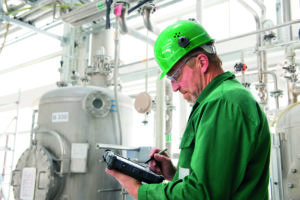How to make your largest industrial investment work harder for you
Why does Asset Performance matter?
If you’re wondering where to start with your digitalization journey, Asset Performance is a key area to address. Why? Because there is so much capital invested in production assets – typically, 70% of new plant capital.
Naturally, you want to see maximum return on that investment – or maximum Return On Capital Employed (ROCE). Your shareholders do too. By the same token, if something happens to these assets it can be a big blow for your financial performance – for example, unplanned down time costs companies up to 5% in production loss each year (ARC Survey of 300 Customers in Discrete, Hybrid and Process Industries).
Clearly a lot depends on the performance of these assets. Let’s take a closer look at how you can use digital technology to improve ROCE.
Improving Asset Performance
So how do you make all that money invested in assets work harder for you, every day?
What’s exciting about the business enabler of Asset Performance is not only that you can reduce the risk involved, but also turn it around to achieve even higher returns. Even better news is that these days there are complete solutions on the market designed specifically to help you do this.
Our customers across mining, water and waste water, and food and beverage, have improved asset performance and reached new levels of efficiency and profitability thanks to the Industrial Internet of Things (IIoT).
The right industrial architecture allows you to link all your assets together at the plant floor and also link them to the cloud if needed. Analytics can look for patterns in data and generate insights. With the right insights generated from your system, you can:
- Move towards prescriptive maintenance which can result in almost zero unplanned downtime (R. Rio, ARC, 2016)
- Reduce maintenance costs by up to 50% (ARC)
- Save up to 30% of energy costs on average (eg. By using our libraries and analytics tools)
The path to maximizing return on your assets
We recommend breaking your asset performance management plan down into three stages.
- Asset reliability –The first step is to use technology to ensure that your assets are always available when you need them. After all, when an asset is down, it’s down. And unplanned downtime costs plants on average 5% of production annually.
- Maintenance excellence – Once you’re confident your assets are working reliably, it’s time to start thinking about your maintenance strategy. In simple terms knowing (even predicting) when you need to fix something and you when you don’t, can save a lot on your maintenance budget – up to 50%.
- Asset Optimization – This is the holy grail of asset performance management, the sweet spot where asset productivity and profitability are optimized while the asset is running. One of the key benefits of Asset Optimization is cutting energy consumption.
That’s a figure which is hard to ignore and one you don’t want to walk away from. To achieve the numbers you’re hoping for, we advise customers choose a fully integrated and comprehensive Enterprise Asset Performance Management (APM) solution. This will allow you to collect and analyse data, along with identifying actions and optimization steps to support proactive maintenance strategies.
You’ll save money, make more profits and your maintenance staff and shareholders will be happier…well maybe!
Learn more about “Data-driven Asset Performance Management” in this new Frost & Sullivan Whitepaper.



Conversation
I cannot agree more, and some of our flash memory controller systems are already integrated in Schneider equipment. They are also in applications requiring less than 30 minutes downtime over a 10 year period with 24/7 utilization. But what I am really interested is the upcoming challenges Schneider will have to resolve in memory storage solutions, and how we can address those in our design today, to give you better solutions in 2 years…
Damien, thanks very much for taking the time to read my blog and to comment! As you point out control system reliability plays a key role in the performance of many of our customer’s assets and we have teams in R&D who strive to improve the reliability of our products on an ongoing basis. I appreciate your commitment to work with us on this key initiative so please continue with your contacts in our product design groups. Every electronic component plays a part in the reliability of our automation products and therefore the performance of the our customer’s production assets. Thank you for your forward thinking approach and willingness to help us as we continually improve the reliability and functionality of our products!